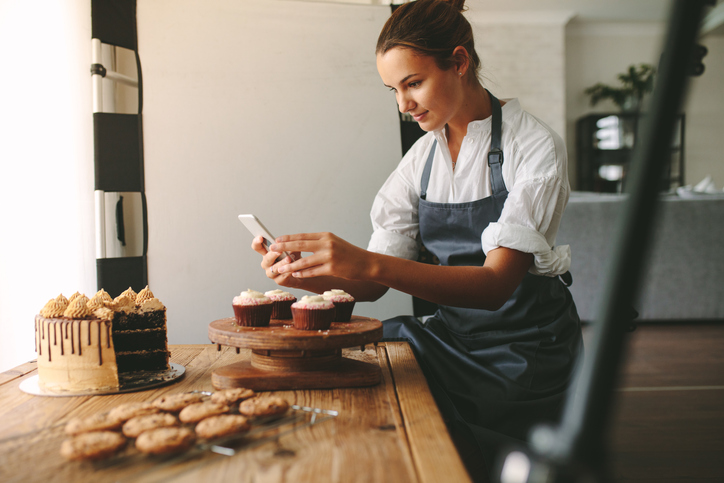
When advertising food and drink products on social media, there are several things brands need to consider in order to stay compliant with the law and avoid reputational damage, especially if working with influencers.
It is safe to say that most food and drink brands have their own Instagram, Facebook and, if alcohol free, TikTok accounts. They therefore cater for an online audience who not only want to buy their products, but who want to engage with the producers themselves.
Brands are becoming more reliant on content creators and influencers to make their feeds insta-worthy, promote brand awareness and/or increase sales. It is commonplace for brands to offer, endorse and/or collaborate on giveaways and competitions, video tutorials, behind-the scenes content and repost users who tag them in their own creations.
That said, there are legal and regulatory considerations which need to be made when taking advantage of the various social media platforms. These include but are not limited to:
- Intellectual property rights in the content
- Lawful use of the content
- Advertising rules
- Regulated product rules
- Giveaway rules
It is important for food and drink providers to build a strategy for social media compliance, including the following:
- Use of content on social media (including sharing user content and content provided by third parties);
- Engaging influencers;
- Advertising rules – including those relating to alcohol, targeting children and nutritional claims; and
- Giveaway rules.
Use of content on social media
The starting point with intellectual property ownership is that the author of the content is the owner of the content. For example, without any agreement to the contrary, a photographer who takes a photograph owns the rights in and to the photograph.
The owner of the content can control and determine how the content is used by third parties. Using a person’s content without the correct mechanisms in place could lead to legal action – which is of course best avoided. Even if flippant permission is given via DMs, this permission can be revoked at any time and the person giving permission might not actually be the legal owner of the content.
It is important to make sure that where you are using third party content that you have a licence in place which is fit for purpose and does not open you up to risk of an intellectual property rights infringement claim. Copyright infringement is a strict liability tort and therefore, intent to infringe is not required.
Engaging influencers
There are a whole host of advertising and promotion rules that both the influencer and the brand need to comply with when engaging in influencer marketing services and/or running online competitions or giveaways. The leading regulatory bodies are the Advertising Standards Authority (ASA), The Committee of Advertising Practice (CAP) and the Competition and Markets Authority (CMA).
If brands continue to disregard the ASA rules or collaborate with influencers who continuously breach the rules, it can significantly damage their reputation when and if the ASA applies sanctions – or if the press get wind of a complaint.
Anyone can report an influencer to the relevant authorities and in 2020, the ASA saw a 55% increase in complaints made against influencers.
Protecting brand reputation
It is important to implement an appropriate influencer strategy which considers the relevant rules, regulations and sets out how your brand will engage with influencers. This can mitigate the risk of reputational damage and help to maintain your brand’s image.
We can provide training to brands on this very topic which can help to upskill your marketing team and help them to self-police compliance with the relevant rules on social media. Our specialist legal advisors recently delivered successful influencer marketing training at Thatchers Cider Company – helping the Thatchers marketing team to understand the rules and regulations on influencer marketing and how best to minimise the risk of getting it wrong.
There is a shift in the marketplace towards a more responsible form of brand promotion. With more awareness amongst consumers and a greater desire for transparency, brands are increasingly taking the initiative to educate the influencers they work with and ensure that they are being represented in the best possible way.
To find out more about how you can get the most out of influencer collaborations whilst ensuring that you are taking the right steps to protect your business and brand reputation, check out our recent article which outlines 5 top tips for brands when engaging influencers.
Regulated products
There are additional advertising rules that apply to regulated products (such as alcohol, nutritional claims and those targeted at children) and these apply regardless of whether the advertiser is the influencer or the food and drink brand’s own social media account.
Advertising alcohol on social media
Alcohol advertisements, including those on social media, must not target or appeal to anyone under the age of 18, nor feature anyone consuming alcohol who is or looks under the age of 25; among several other key rules.
We have recently published an article on the importance of influencer agreements when promoting alcohol products on social media and we provide training and advice to businesses on this very topic. It is of fundamental importance that those who sell and advertise alcohol understand the rules on marketing alcoholic drinks on social media.
It may also be sensible for alcohol brands to consider the relevant rules when promoting their non-alcoholic products too. Not least because, if advertised alongside their usual alcoholic products – the non-alcoholic products may be perceived by advertising regulators as a gateway product to the brand’s alcoholic products.
High fat, salt or sugar products
As with alcoholic drinks, brands whose products fall under the Department of Health’s “HFSS” category (High in Fat, Salt or Sugar) must comply with the relevant rules when advertising such products on social media platforms.
For example, HFSS product advertisements that are targeted directly at pre-school or primary school children must not include licensed characters or celebrities popular with children (rule 15.15 CAP Code). This section of the CAP Code was breached when the Care Bears were used to advertise Kinder Chocolate Bars on a YouTube channel whose primary audience was children under 16 years of age.
Additionally, advertisements for HFSS products are prohibited from appearing on so-called “mixed-age media” platforms, meaning where more than 25% of its users are under 16 years old (rule 15.18 CAP Code) – this typically means platforms like TikTok and Snapchat, but this does not mean that other social media platforms are less of a risk for advertisers.
The ASA is taking steps to encourage brands and advertisers to make better use of the social media platform’s ad targeting tools; this should help limit the number of HFSS products being advertised or promoted to under 16 year old users on mixed-age media platforms.
For example, the “Chewits” brand breached the CAP Code when advertising on Facebook because, though their ads did not target children under 16 years old, it would have been “pushed out” to users who were registered as under 16 and was visible on the brand’s Facebook page to users registered as under 16, even if the users had not liked or followed the page. This is because the brand had not restricted the audience of their Facebook page to those users registered as aged 16 or over. Neither had they utilised the interest-based settings to target their individual Facebook posts to the newsfeeds of those aged 16 or over.
The ASA also have the power to ban ads where the advertiser is unable to provide robust evidence that over 75% of the target audience are over 16 years old.
Nutritional claims in social media ads
Another area where brands should be cautious, irrespective of the age of the advertisement audience, is where it makes nutritional claims. This is something that the ASA stringently monitors and actively challenges claims which breach their rules on the same.
For example, the ASA ruled against Organic Burst for an Instagram ad which promised the consumer it would help them “look and feel amazing fast”.
Giveaways
If you launch a free prize giveaway on social media, there are several things you need to do before sharing the giveaway post on your feed to avoid having the post taken down, or having action taken against you.
A key starting point is to make sure that the post and any videos, reels, stories, IGTVs promoting or endorsing the same, complies with both the relevant social media platform’s terms and conditions and the relevant advertising and promotional marketing rules and regulations.
The Advertising Standards Authority (ASA) recommend that promoters take legal advice before embarking on promotions with prizes, including competitions, prize draws, instant-win offers and premium promotions, to ensure that the mechanisms involved do not make them unlawful lotteries under the Gambling Act 2005.
The individual running the giveaway is responsible for all stages of the competition and the giveaway must be suitable for the target audience; a social media platform’s insights and/or analytics tools can help you determine the age range of your followers and therefore, who your “target” audience is.
For more information, check out my article on giveaways here.
The risks of advertising on social media
Ultimately, there is a risk of reputational damage in respect of social media slip-ups, and these are best avoided by careful consideration of the rules and undertaking proper due diligence prior to using influencers to promote products on social media. It is important for a brand to have a comprehensive influencer strategy which carefully considers the rules and regulations to mitigate the risk of reputational damage.
There is also an inherent risk in the right (or lack of right) to use content created and/or shared on social media – ensuring that the correct licensing provisions and agreements are in place to mitigate the risk of intellectual property infringement is key.
We can provide guidance on all aspects of social media brand promotion, including giveaway rules, drafting giveaway terms and conditions, influencer contracts and considering the use of influencers more widely, including providing training to your marketing team. Please get in touch if you have any questions.
